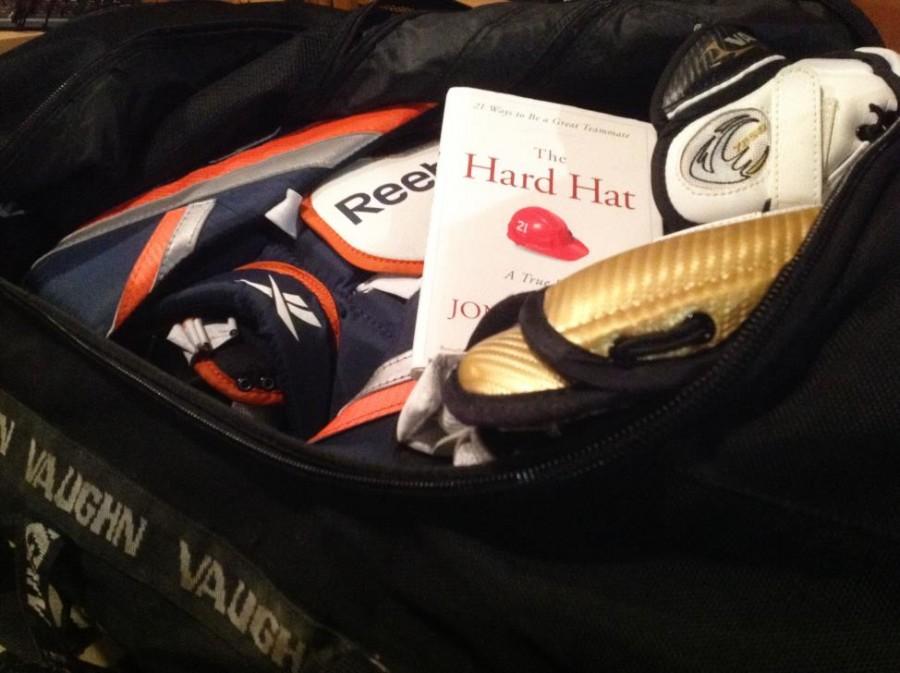An intervention in disguise
A new meaning to the number 21
For most high school teams, the beginning of a sports season is marked by a round of tryouts, conditioning, and team building. For us returning varsity ice hockey players, however, the first assignment was actually an assignment– required reading.
“When I first heard that were we being assigned reading, I thought it was unnecessary and kind of ridiculous,” said sophomore forward Maddie Rennie.
Naturally, I felt the same way when I checked my email in early September and came across this message from our coach: “Mercy players, I am assigning a book to you for some required reading. The title of the book is The Hard Hat. The author is Jon Gordon. You have one month to read it, and we will have discussions about it once the season starts.”
At first I thought he couldn’t be serious. It seemed ridiculous, reading for a sport. What could this book possibly do for us out on the ice? I wanted to ignore the task, maybe get the summary from a teammate, but decided to at least do some research into this book my coach deemed so important.
Expecting Barnes and Noble or Amazon to pop up in response to my Google search, I was genuinely surprised to arrive at an official website, equipped with bullet points on the purpose of The Hard Hat and a video made in honor of the story. It was here that I first delved into the life of Mario St. George Boiardi.
Boiardi, who went by his middle name George, was a lacrosse player at Cornell. Anyone who knew him, however, would say that he was much more than that. Deemed an exemplary, quiet leader, Boiardi lived by the motto “well done is better than well said.” He did everything he could to make himself and those around him better, both on and off the field. Boiardi pushed his limits and, in doing so, inspired his teammates to push theirs. He played for the team, not for himself. It was this dedication that led the senior captain to jump in front of a shot and block it with his chest at a crucial point in a close game. The shot was stopped, but it took the heart of the Cornell lacrosse team down with it. After learning of this tragedy, I decided that I had to read the book. It was an eye-opening experience that has been on my mind ever since I closed the back cover.
Gordon, the author, upon learning of Boiardi, noticed how much of an impact Boiardi’s memory continued to have on Cornell’s lacrosse organization today. His locker is left untouched. His number, 21, is bestowed on the side of a red hard hat that travels with the team, reminding them to work as hard as they can with the team and for the team, just as Boiardi had done.
As I went on, I realized that it isn’t just the tragedy or the player he was that lives on in the memories of his teammates, coaches, family and friends, but the person Boiardi was and the way he lived his life. It was the little things he would do out of pure kindness and respect for everyone that keeps people coming together each year to remember him. He always stayed behind to clean up after his teammates, leaving the locker room better than he found it. He stuffed 12 of his teammates into his car so that no one was left to walk through the snow across campus. He got to know his teammates personally, and, in doing so, formed a mutual respect with each of them. This is what my coach wanted us to learn; this was an intervention.
“I learned that you can make a big impact in the way that you lead,” said junior forward Natalie Vaitas. “Others can take away that you don’t have to be a vocal leader. You can lead by example and still make an impact on others.”
People have the potential to leave a mark on those around them. It’s the best marks, though, that govern positive results for quite some time.
“Sometimes unexpected things happen, and it takes some teamwork and strength to overcome adversity,” said Rennie. “George was a great example of a person and a teammate. His death was a tragedy, but his lessons will be taught for a long time.”
Without ever meeting him, Boiardi made me look at myself and realize that I am a work in progress. In fact, our whole team is a work in progress. Only we can define how we progress and where we end up. With 21 new ways to be the best teammates we can be, we can go into the season with the intent to play for each other. A most valuable lesson to have in the back of our minds as we take the ice.
“I would like this to impact our perspectives on each other and make us work harder than we ever have before,” said Rennie. “We can use the lessons toward the end of the book to try to become better athletes and better people.”
It’s weird to think that if it weren’t for a tragedy, Boiardi’s lessons may not have been shared. He would have gone on inspiring those around him, but not to the extent that he has with this book. Twenty-one is Boiardi. Twenty-one is everything the hard hat stands for. Now, 21 is something to remember on the road to becoming a better person.

